French Defense: Complete Guide for Both Colors
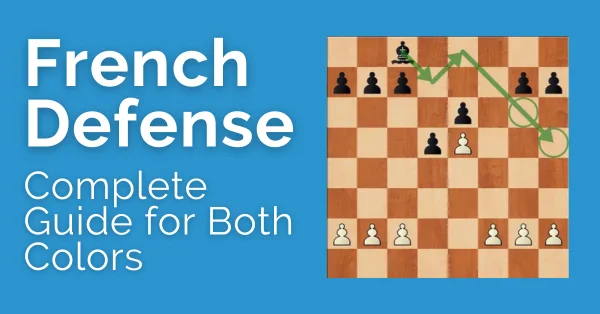
The French Defense is a vast opening. It has a distinct flair to it that attracts players of all strengths. Some players like Wolfgang Uhlmann are such devout French players that they have played only the French defense throughout their entire career.
Being such a rich and vast opening, it is important to start right from the basics and slowly progress towards mastery of the opening.
This article gives you the foundational knowledge that a player needs to start playing the French Defense.
French Defense: What is it?
French Defense is an Opening for Black that starts with moves: 1.e4 e6
It is so popular that a wide range of players opt for it; from beginners to Super Grandmasters.
Black’s idea in this opening is to place a solid pawn wedge in the center (e6-d5). This structure is not indestructible as White can change this structure. This will lead to different pawn structures in the center. If you want to master the French Defense then these structures are essential. The typical pawn structures are discussed below.
The French Defense is such a rich opening that you cannot attack a single tag to it (for example, saying it is a closed opening) The center can be closed or open depending on the line chosen by both players.
Therefore, it is a great opening to develop one’s understanding of the game.
Why Play the French Defense
What makes the French so attractive is the fact that above all it is a battle of ideas. You get variations where the fight is between the static and dynamic factors. At the same time, you can also get completely symmetrical positions that require precise maneuvering.
This wide range of possibilities makes the French Defense stand out from the rest.
Learning such a deep and complex opening can feel challenging. This can be overcome by starting from the basics of the opening and progressing further step by step.
If you decide that you want to play the French Defense as Black then it is a good idea to first look at all the model games in this article. This will give you a nice overview of the opening from both sides.
If you feel comfortable with the positions in the game then you can continue with the further study of the French Defense. If not as well then, no problem, taking up the French Defense will surely teach you different unseen aspects of chess.
French Defense with Black or White
French Defense from White
To play the French Defense from the White side there are some strategic concepts that you need to know. A central theme in the advanced variation of the French Defense is the Central Pawn Wedge.
White’s Central Pawn Wedge
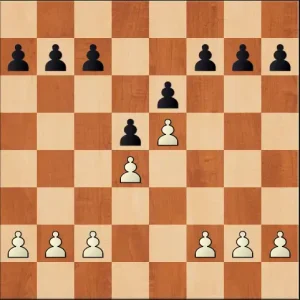
With the constricting move 3.e5 White announces his intentions to claim space advantage and a possible kingside attack. These concepts will play a decisive role throughout the game. The pawn thrust to e5 changes the position for White in two ways
- White’s pawn chain on the dark squares confers a space advantage.
- White’s Bishops acquire greater mobility compared to Black’s.
Therefore, if White succeeds in developing his pieces into good squares, then he will have better chances in the ensuing middlegame. Now unless Black does something, he’s going to be crushed.
Black counters this by putting maximum pressure on the center. Ideally what Black wants is to destroy White’s center. Therefore, Black aims to play the c5 and f6 break. Later the Black’s pieces will spring into action to occupy the weakness left over as a consequence of the pawn advances.
But more often than not it is not easy to destroy White’s center. Instead, Black argues that White to support his pawn center has to develop his Queenside pieces unnaturally. This time-consuming maneuvering and positioning by White will negate the benefits of his Space advantage.
French Defense from Black
In the opening stage, Black’s strategy mostly revolves around generating counterplay in the center and the Light Squared Bishop.
Black’s Queen Bishop
In the starting position of the French Defense, White has open diagonals for both the bishops. In contrast, things are not so simple in Black’s camp. Playing 2..e6 opens the door for the f8 bishop but closes the diagonal for the c8 bishop. The Black e-pawn is unlikely to advance; thus, the bishop on c8 has no immediate future on the c8-h3 diagonal.
So how to solve the problem of the bishop? It can be developed on b7 after the b6 pawn push or on c6 after the Bc8-d7-c6 maneuver. But this post is not so great because the black pawn on d5 is set in stone.
By process of elimination, the only post nearby is a6. This post holds promise for the bishop as it is often exchanged for the white bishop on f1.
In the following game, GM Yasser Seirawan executes this plan. Then proceeds to use the absence of the light-squared bishop by posting a knight on f5 (A typical post for the knight in the French Defense).
Timman – Seriawan, Lone Pine 1978
What if you want to preserve the light-squared bishop and post it to an active square? It is possible to achieve this. This is one of the most common maneuvers in the French Defense.
- Activating the light-squared bishop via d7-e8
It is possible to activate the bishop through a long maneuver. The path taken by the Bishop is c8-d7-e8-g6/h5. This is typically seen in the variation where Black plays f6 or pushes the f-pawn.
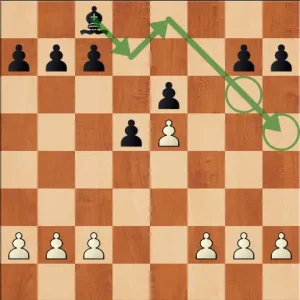
The maneuver costs several tempi but this is where the closed nature of the opening helps us. Since the position is closed, White cannot play actively to punish Black for using several tempi on a Bishop.
Understanding French Pawn Structures
Closed Center
We get the Closed center from the Advance Variation. When the center is closed action will take place on the wings.
- White’s Plans
Since White has the Space advantage White should attack the part of the board where the opponent is weaker. In the French, White achieves this by playing for a pawn attack with f2-f4 -f5 and g2-g4. The idea is to open up lines for the pieces where Black is weaker.
Even if a successful breakthrough is not feasible then the space advantage gained due to f4-g4 thrusts can be used for the pieces. White can slowly build up his pieces on the Kingside for a future attack.
- Black’s Plans
Black should prepare counterplay quickly. The counterplay should come from a central pawn breakthrough.
Black does this primarily in two ways through the c5 and f6 breaks. He should be mindful that these pawn breaks can change the nature of the center.
Black can also aim for counterplay on the wings. Since White has the upper hand in the center Black should be careful and stop any direct threats from White first before proceeding with his plans.
Isolated Pawn Center
The isolated pawn center positions arise a lot in the French. It is often seen in the Tarrasch variation. This pawn structure can also be reached via the Exchange variation. The typical ideas for an Isolated Queen Pawn (IQP) apply for these positions.
White has a good square for his pieces in front of the isolated pawn on d4. White can post a knight on this square.
Black has played down the c and e files. The c4 and e4 squares are possible outposts for his pieces.
For more details on How to Play the IQP check out this guide.
Backward Pawn Center
The Backward pawn center arises when Black executes the f6 break and White exchanges on f6. The e6 pawn is a static weakness that needs constant attention.
- White’s plans
White has a potential outpost on e5 for a knight. He can also target the backward e-pawn with this Rook and Queen.
The following game shows how White can exploit these weaknesses.
Karpov-Hort, Budapest 1973
- Black plans
From the above game, it is clear that Black must play actively and look for counterplay. Black has the half-open f-file for counterplay. Since Black has accepted a long-term static weakness, he has to play actively to compensate for it. Pieces exchanges should be generally avoided because endgames would be better for white.
The following game shows the attacking potential of Black’s position
Govedarica – Uhlmann, Vrbas 1977
How to play French Defense: The Most Popular Variations
In this section, we will take a look at all the lines that arise after 1.e4 e6 2.d4 d5 These are the mainlines and the most popular variations of the French Defense.
At the end of each section, we have provided you with the statistics of respective variations of the French defense. It shows the Win rate for White and Black and the percentage of draws.
You can use this to assess how these variations perform in club and master-level games. (Data is derived from the Lichess database)
French Defense: Advance Variation
The Advance Variation arises after the moves 1.e4 e6 2.d4 d5 3.e5
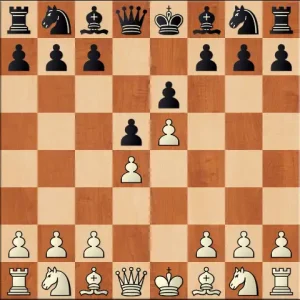
Here we see that the center is Closed and has the typical central pawn wedge.
For white, d4 forms the base of the pawn chain. This makes the d4 square a prime concern for both sides. Black can further pressure the pawn with maneuvers like Nbc6 and Qb6. Another common maneuver is Ng8-h6-f5.
White counters these maneuvers by playing Nf3 and Na3-c2 to support the d4 pawn. Both the Knights do a good job of defending the vital d4 point.
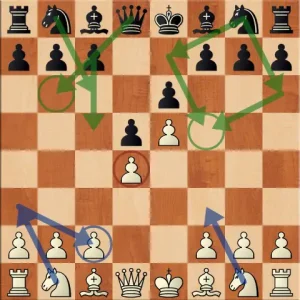
From the initial maneuvering, it may seem that the position is calm but a quick central break can change the situation drastically.
White is happy to develop normally and realize his space advantage methodically. Black on the other hand has to actively look for counterattacking opportunities.
Model Game: Moehring vs Uhlmann, 1982
- Statistics for Advance Variation of the French Defense
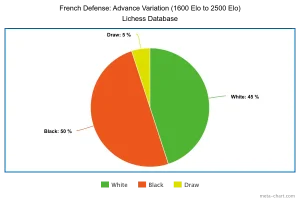
French Defense: Advance Variation – The Modern 6.a3
The enterprising move 6.a3 has become popular in recent times. The real question is can White afford to play a non-developing move when Black has his eyes on d4?
The answer is yes. Since the position is closed, White is just in time to organize counterplay. The idea behind a3 is to play b4 and pressure the c5 square.
Evgeny Sveshnikov was one of the foremost experts of the advanced variation. In this game, he demonstrates the key ideas in the 6.a3 line.
Model Game 1: Sveshnikov – Casper, 1987
Model Game 2: Grischuk – Vitiugiov, Moscow 2010
French Defense: Exchange Variation
The Exchange variation arises after the moves 1.e4 e6 2.d4 d5 3.exd5 exd5
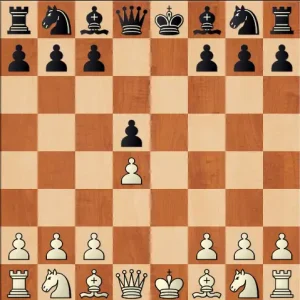
The position might look equal but it does not lead to a dead draw. Since the pawn structure in the center cannot be easily altered the minor pieces determine the pattern of play.
Bishops are especially important in these positions. They have several possibilities for deployment on long diagonals.
One of the key ideas for Black is to exchange the light-squared Bishops. Black hopes to achieve this by Ne7 followed by Bf5. Naturally, White can also use the same method (Ne2 and Bf4) to look for an exchange.
The key to keeping the position active is to play asymmetrically. Either side can obtain an advantage with a slight slip from the opposition. An interesting option is to castle on opposite wings to generate chances.
Model Game: Kovacs – Kortchnoi
- Statistics for Exchange Variation of French Defense
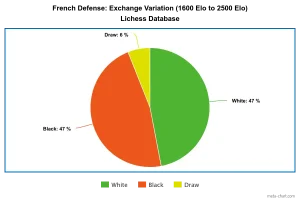
French Defense: Winawer Variation
The Winawer Variation arises after 1.e4 e6 2.d4 d5 3.Nc3 Bb4
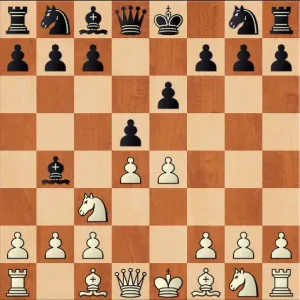
Unlike the Advance and Exchange variations, White looks to maintain the tension in the center with 3.Nc3. The principal idea of the Winawer variation is to create dynamic imbalances.
Black creates this imbalance through the exchange of the Bishop for the Knight. After 3..Bb4 the bishop is ready to be exchanged for the knight on c3. After the exchange c2-c3 pawns are weak. Therefore, the pawn structure on the Queenside favors Black.
White’s strategy is that he has the two bishops. The dark-squared Bishop becomes an important piece as it has no counterpart. White often uses the a3-f8 diagonal to generate play. Subsequently the move a4 with the idea Ba3 was one of Fischer’s favorites against the French Defense.
In the Winawer Black is eager to transform the game into an endgame as he has better prospects due to White’s static weaknesses.
Hence it is a battle of Statics vs Dynamics. A battle of ideas. Therefore, Winawer games are generally very tactical with counterattacking chess at its core.
- Statistics for Winawer Variation of French Defense
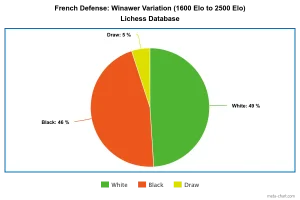
French Defense: Tarrasch Variation
We get the Tarrasch variation after the moves 1.e4 e6 2.d4 d5 3.Nd2
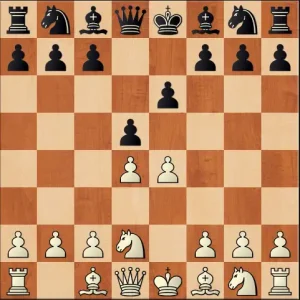
Similarly to 3.Nc3 with 3.Nd2 White aims to retain the tension in the center. The reason for putting the Knight on d2 is to discourage Bb4. If Black plays Bb4 now then white can play c3. White aims for a long-term strategic buildup in these positions.
The consequence of the move 3.Nd2 is that it doesn’t put much pressure on the center and thus gives Black a free hand. Black has two fundamental ways of approaching the game.
Black can liquidate the game with 3..c5 to get free play for his minor pieces.
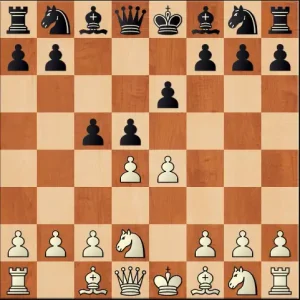
The model game demonstrates how to play this French Defense line as White.
Model Game: Karpov – Uhlmann, Madrid 1973
Another choice is to play 3..Nf6 This leads to a different type of game than 3..c5
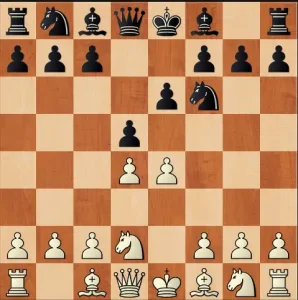
Now White closes the center with 4.e5. With this move, we transpose to the Central pawn wedge structures.
- Statistics for Tarrasch Variation of French Defense
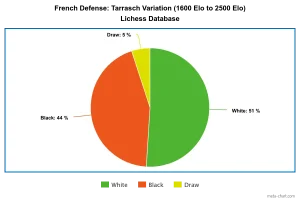
French Defense: Classical Variation
The Classical variation starts after 1.e4 e6 2.d4 d5 3.Nc3 Nf6
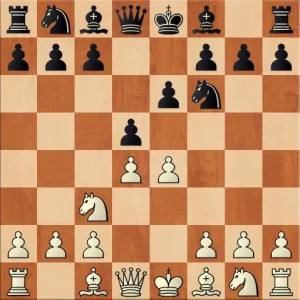
The move 3..Nf6 invites White to change the nature of the center. White can play e5 and we get the Central Pawn Wedge.
After 4.e5 Nfd7
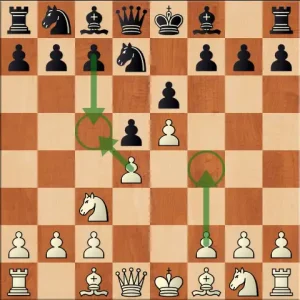
Black can quickly counter in the center with c5. The difference in the position is that the White knight is on c3 so White doesn’t have the immediate option of c3 to defend the d4 point. This is the point of Black’s play as Black argues White’s pieces are clumsily placed to defend the central pawn structure.
White has another idea in mind. After the d4 pawn is exchanged White bolsters the center with f4. This leads to an interesting battle for d4 point since it is empty and the space advantage on the Kingside for White gives him attacking chances.
The following game shows the typical ideas in this line.
Model Game: Kasparov – Timman, Horgen 1995
But the move 4.e5 is not forced, as White can also maintain the tension for one more move by 4.Bg5.
Here Black can play 4..Bb4 and ignore the threat of e5(this leads to the MacCutcheon Variation of the French Defense) In theory, the move Bg5 can lead to several other lines like 4..dxe4, 4..Be7.
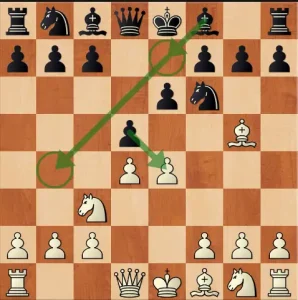
- Statistics for Classical Variation of French Defense
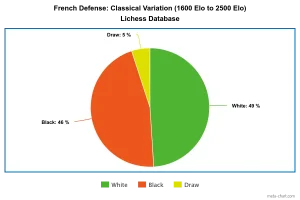
French Defense: The King’s Indian Attack
White can employ the universal King’s Indian Attack against the French defense. White aims to play a line resembling the King’s Indian Defense.
1.e4 e6 2.d3
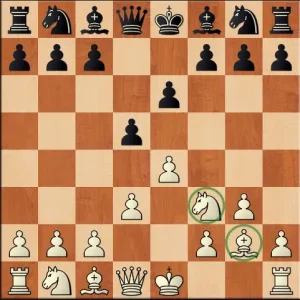
The positions are generally of a closed nature. This means that both sides should the standard maneuvers and piece placements. This positional struggle can quickly transform into a tactical melee if the position opens up.
White’s strategy is to stabilize the center and go for a slow Kingside expansion. Black usually plays on the Queenside with space-gaining moves like b5 and c5. The c4 break is an important idea for Black to gain counterplay.
In this system, both sides carry out their respective attacking plans, more or less regardless of each other.
Model Game: Savon – Uhlmann, Skopje 1968
- Statistics for King’s Indian Attack Variation of French Defense
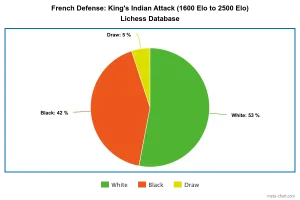
French Defense: The Rubinstein Variation
The Rubinstein Variation of the French Defense is a universal weapon for Black against both Nc3 and Nd2.
It arises after the moves 1.e4 e6 2.d4 d5 3.Nc3 dxe4
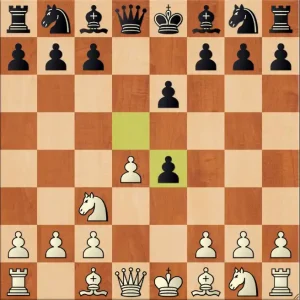
With the move dxe4, Black gives up the advanced central pawn (d5). This means that he no longer enjoys a space advantage in the center.
Black aims to compensate for this with quick development and counter in the center.
White aims to use his central pawn as a support for his piece in the center and go for an attack. However, this is not easy as Black will play energetically in the center to disallow any Kingside attack.
In the following game, Kasparov demonstrates how to conduct an attack when the opponent falls behind in development.
Model Game: Kasparov – Ponomariov, Linares 2002
- Statistics for Rubinstein Variation of French Defense
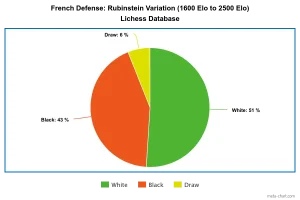
French Defense: MacCuthcheon Variation
In the Classical line of the French Defense, After Bg5 Black plays the enterprising move Bb4.
1.e4 e6 2. d4 d5 3. Nc3 Nb4 4. Bg5 Bb4
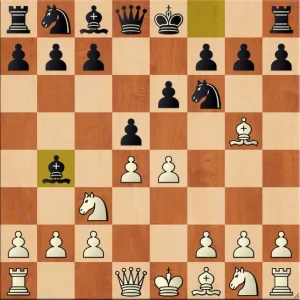
This aggressive counterpunch aims to dissuade White from undertaking active counterplay in the center. The first question you might get is, Is it possible to win a piece with 5.e5?
Unfortunately no, as Black has the saving resource 5..h6 and 6..g5
Even though you cannot win a piece, 5.e5 is the principled continuation after Bb4. This move gains space and poses a question to the Knight. The game plan for white is to attack the Kingside with pawn thrusts (h4-g4) and piece play.
Black has to make sure the center is stable and aim for Queenside counterplay with the semi-open c file (after an eventual Bxc3 in the opening).
The following game features these typical ideas:
Model Game: Vishwanathan Anand – Alexei Shirov, Bilbao 2010
- Statistics for MacCuthcheon Variation of French Defense
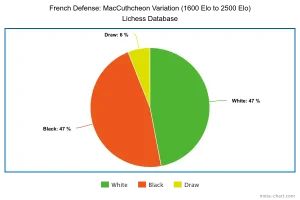
Tricks and Traps in the French Defense
The Rubinstein Variation Trap
Rubinstein Smothered Mate
Winawer Discovered Attack
Winawer Queen Trap
Weaknesses in the French Defense
The French Defense has two main ‘weaknesses’. These are positional factors that should always be in the back of your mind.
- Lack of Space
When White pushes forward with e5, Black gives up space. Of course, Black has a strategy in place to combat. But it is good to be mindful of it. Because misplaying the position means Black will end up in a cramped position with no prospects.
- Black’s Light Squared Bishop
As discussed above, this is the problem piece for Black in the French Defense. If you play the French Defense with Black you will realize that there are more subtle ways of handling the light-squared bishop.
Chess Courses About French Defense
After reading this article you can try your hand with the French Defense. After some games, you will realize that you need further knowledge of the opening.
At TheChessWorld, we have many courses that cater to this need. These courses are curated by master-level players and teach you many nuances and tricks in the French Defense.
Here are the courses:
- Modern French Defense: Complete Repertoire for Black with IM Kushager Krishnater
- Beat the French Defense with 3.Nd2 by IM Zaur Tekeyev
- French Defense with IM Marcin Sieciechowicz
- French Defense – Opening Lab with GM Marian Petrov
FAQ:
Is the French defense aggressive?
Yes, some variations of the French defense are aggressive and tactical.
Why is it called the French defense?
The opening was named the French Defense after it was first played in a correspondence match between Paris and London.
What are the main lines of the French defense?
The current main line of the French Defense is the Advance variation.
Is French Defense a positional opening?
The French Defense is also a positional opening. Many variations lead to a quiet struggle where positional understanding is essential.
Is the French Defense Good for Beginners?
The French Defense is a playable opening for Beginners but it requires work from their side. It is a complex opening with many strategic ideas, so beginner players should not be discouraged if they lose a few games without any fight.




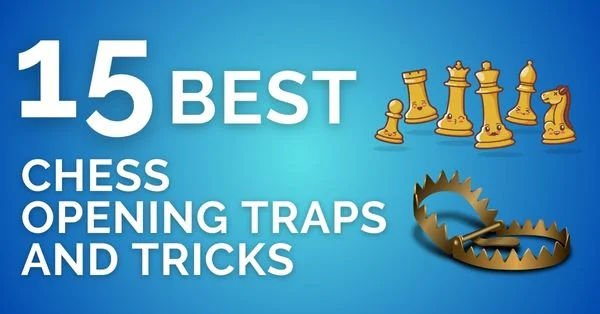





Comments: